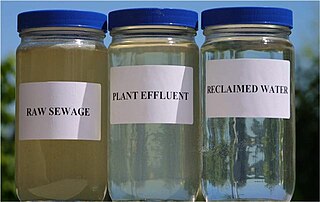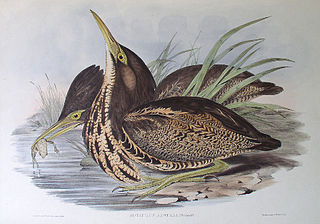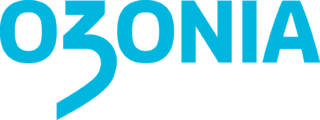
NEWater is the brand name given to highly treated reclaimed wastewater produced by Singapore's Public Utilities Board. NEWater is produced by further purifying conventionally treated wastewater through microfiltration, reverse osmosis and ultraviolet radiation. The water is potable quality and can be added to drinking water supply reservoirs where it is withdrawn and treated again in conventional water treatment plants before being distributed to consumers. However, most NEWater is currently used for non-drinking purposes, mostly by industries with production requirements for high purity water.

Western Port, commonly but unofficially known as Western Port Bay, is a large tidal bay in southern Victoria, Australia, opening into Bass Strait. It is the second largest bay in the state. Geographically, it is dominated by two large islands; French Island and Phillip Island. At the time it was renamed, its position was west of other known ports and bays, but Western Port has become something of a misnomer as it lies just to the east of the larger Port Phillip and the city of Melbourne. It is visited by Australian fur seals, whales and dolphins, as well as many migratory waders and seabirds. It is listed under the Ramsar Convention as a wetland of international significance.

Water reclamation is the process of converting municipal wastewater or sewage and industrial wastewater into water that can be reused for a variety of purposes. It is also called wastewater reuse, water reuse or water recycling. There are many types of reuse. It is possible to reuse water in this way in cities or for irrigation in agriculture. Other types of reuse are environmental reuse, industrial reuse, and reuse for drinking water, whether planned or not. Reuse may include irrigation of gardens and agricultural fields or replenishing surface water and groundwater. This latter is also known as groundwater recharge. Reused water also serve various needs in residences such as toilet flushing, businesses, and industry. It is possible to treat wastewater to reach drinking water standards. Injecting reclaimed water into the water supply distribution system is known as direct potable reuse. Drinking reclaimed water is not typical. Reusing treated municipal wastewater for irrigation is a long-established practice. This is especially so in arid countries. Reusing wastewater as part of sustainable water management allows water to remain an alternative water source for human activities. This can reduce scarcity. It also eases pressures on groundwater and other natural water bodies.

Seaford is a beachside suburb in Melbourne, Victoria, Australia, 36 km south-east of Melbourne's Central Business District, located within the City of Frankston local government area. Seaford recorded a population of 17,215 at the 2021 census.

The Bellarine Peninsula is a peninsula located south-west of Melbourne in Victoria, Australia, surrounded by Port Phillip, Corio Bay and Bass Strait. The peninsula, together with the Mornington Peninsula, separates Port Phillip Bay from Bass Strait. The peninsula itself was originally occupied by Indigenous Australian clans of the Wadawurrung nation, prior to European settlement in the early 19th century. Early European settlements were initially centred on wheat and grain agriculture, before the area became a popular tourist destination with most visitors arriving by paddle steamer on Port Phillip in the late 19th century.

Devilbend Natural Features Reserve is a 1,005 ha natural reserve park in the rural locality of Tuerong on the Mornington Peninsula in central southern Victoria, Australia, 55 km (34 mi) southeast of the state capital Melbourne's city center.

Arcata Wastewater Treatment Plant and Wildlife Sanctuary is an innovative sewer management system employed by the city of Arcata, California.

Ultraviolet germicidal irradiation (UVGI) is a disinfection technique employing ultraviolet (UV) light, particularly UV-C (180–280 nm), to kill or inactivate microorganisms. UVGI primarily inactivates microbes by damaging their genetic material, thereby inhibiting their capacity to carry out vital functions.

The Western Treatment Plant is a 110 km2 (42 sq mi) sewage treatment plant in Cocoroc, Victoria, Australia, 30 km (19 mi) west of Melbourne's central business district, on the coast of Port Phillip Bay. It was completed in 1897 by the Melbourne and Metropolitan Board of Works (MMBW), and is currently operated by Melbourne Water. The plant's land is bordered by the Werribee River to the east, the Princes Freeway to the north, and Avalon Airport to the west. It forms part of the Port Phillip Bay and Bellarine Peninsula Ramsar Site as a wetland of international importance. The Western Treatment Plant treats around fifty percent of Melbourne's sewage — about 485 megalitres or 393 acre-feet per day — and generates almost 40,000 megalitres or 32,000 acre-feet of recycled water a year.

The Patterson River is a partly man-made urban river of the Port Phillip catchment in the Australian east coast state of Victoria, located in the outer southeastern suburbs of the Greater Melbourne region. Under the name "Patterson", it is the shortest river in Victoria at only 5 km (3.1 mi) in length, although its main stem tributary and de facto upper section, the Dandenong Creek, is over 53 km (33 mi) long.

The Ashbridges Bay Wastewater Treatment Plant is the city of Toronto's main sewage treatment facility, and the second largest such plant in Canada after Montreal's Jean-R. Marcotte facility. One of four plants that service the city of Toronto, it treats the wastewater produced by some 1.4 million of the city's residents and has a rated capacity of 818,000 cubic metres per day. Until 1999 it was officially known as the Main Treatment Plant. The plant has a 185 m (607 ft) high smokestack which is visible from most parts of the city.

Sewage treatment is a type of wastewater treatment which aims to remove contaminants from sewage to produce an effluent that is suitable to discharge to the surrounding environment or an intended reuse application, thereby preventing water pollution from raw sewage discharges. Sewage contains wastewater from households and businesses and possibly pre-treated industrial wastewater. There are a high number of sewage treatment processes to choose from. These can range from decentralized systems to large centralized systems involving a network of pipes and pump stations which convey the sewage to a treatment plant. For cities that have a combined sewer, the sewers will also carry urban runoff (stormwater) to the sewage treatment plant. Sewage treatment often involves two main stages, called primary and secondary treatment, while advanced treatment also incorporates a tertiary treatment stage with polishing processes and nutrient removal. Secondary treatment can reduce organic matter from sewage, using aerobic or anaerobic biological processes. A so-called quarternary treatment step can also be added for the removal of organic micropollutants, such as pharmaceuticals. This has been implemented in full-scale for example in Sweden.

Port Phillip is in Victoria, Australia. It has many beaches, most of which are flat, shallow and long, with very small breaks making swimming quite safe. This attracts many tourists, mostly families, to the beaches of Port Phillip during the summer months and school holidays. Water sports such as body boarding and swimming are common, though waves are very rarely large enough for surfing. A number of lifesaving clubs operate along Port Phillip’s beaches.

South East Water is one of three Victorian Government owned retail water corporations that provides drinking water, sewerage, trade waste, recycled water and water-saving services for residents and businesses in an area ranging from the south-east of Melbourne to south Gippsland in Australia. The water distributed by South East Water is supplied by Melbourne Water, as is the infrastructure. Oversight is provided by the Department of Environment, Land, Water and Planning.

The Edithvale–Seaford Wetlands is a collection of principally freshwater swamps and marshlands totalling 261 hectares in southeastern Melbourne, Australia, about 30 km (19 mi) southeast of Melbourne CBD. It is the largest natural wetland of its type in the Port Phillip and Western Port basins, and is all that remains of the historic Carrum Carrum Swamp, which once covered more than 4,000 hectares from present-day Mordialloc in the north to Frankston in the south.

Degrémont is a company specializing in the production of drinking water, and in the treatment of sewage and sludge. After starting as a family business in France in 1939, it has since become a subsidiary of Suez Environment, employing 4,600 people in 70 countries, and generating annual revenues of €1.520 billion.

The Griffith Wetlands Important Bird Area is a group of wetlands lying close to the Riverina town of Griffith in southern New South Wales, Australia. It lies within the Murrumbidgee Irrigation Area.

The North Victorian Wetlands, also known as the Kerang Wetlands, comprise an extensive series of over 100 freshwater, brackish and saline lakes and swamps on the floodplain of the Loddon River where it enters the Murray valley, in the vicinity of the town of Kerang, in northern Victoria, south-eastern Australia. They are important for a variety, and sometimes large numbers, of waterbirds.
The Catskill-Delaware Water Ultraviolet Disinfection Facility is a 160,000-square-foot (15,000 m2) ultraviolet (UV) water disinfection plant built in Westchester County, New York to disinfect water for the New York City water supply system. The compound is the largest ultraviolet germicidal irradiation plant in the world.

Ozonia is a multinational water treatment equipment manufacturer headquartered in Zürich, Switzerland.


















